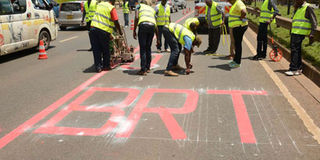Bus rapid transit cog in wheel to better commute

Road engineers mark a lane on Thika highway designated for bus rapid transit system, on April 5, 2018. Strict enforcement of the dedicated lanes operation is vital to ensure non-obstruction from unauthorised vehicles. PHOTO | KANYIRI WAHITO | NATION MEDIA GROUP
What you need to know:
- Poor traffic regulations compliance greatly contributes to reduced capacity on the road network, hence delays.
- Most of the private and public commute is characterised by low-occupancy cars, vans and minibuses.
- Traffic engineers estimate a capacity reduction by half if one traffic lane on a three-lane road is blocked.
The Nairobi commute is a nightmare many can only whine about.
It is characterised by lengthy delays, inadequate infrastructure, coarse driver behaviour and non-adherence to traffic regulations amalgamating into a roving hodgepodge.
Therefore, when Transport Cabinet Secretary James Macharia unveiled dedicated lanes on some city highways for a high-capacity bus rapid transit (BRT) system, I was astounded by the level of criticism directed at it.
Admittedly, the ‘red lanes’ — or “lipstick on roads”, as christened by some — will not singularly resolve the city’s traffic challenges and require tweaks.
But they are a vital cog in the wheel to a functional transport system.
TRAFFIC LIGHTS
Most of the private and public commute is characterised by low-occupancy cars, vans and minibuses.
The result is vast volumes of vehicles accessing the city at peak times with enormous pressure on the roads.
BRT enables high-capacity buses using dedicated traffic lanes and prioritised access at road junctions to transport large volumes of commuters rapidly with less pressure on the roads.
However, for the system to be effective, it is crucial to prioritise the movement of the buses through road junctions by use of intelligent traffic lights with BRT sensors to facilitate seamless journeys.
Junction prioritisation may be onerous to implement, imminently due to the state of road infrastructure, but once in place the benefits should be evident.
Strict enforcement of the dedicated lanes operation is vital to ensure non-obstruction from unauthorised vehicles.
DRIVERS
The ongoing road expansion should continue and other mass rapid transit systems, such as light rail, urgently developed to complement BRT buses.
Poor traffic regulations compliance greatly contributes to reduced capacity on the road network, hence delays.
This is manifested in recalcitrant driver behaviour of matatu drivers and boda boda riders, lane indiscipline, non-compliance with traffic signals and stopping at non-designated locations, among other ills, with intermittent lane blockage.
Traffic engineers estimate a capacity reduction by half if one traffic lane on a three-lane road is blocked.
Journey times into the city could, therefore, be vastly improved if drivers followed the rules.
DISCIPLINE
Non-compliance has been crystallised into impunity by deficient and often venal enforcement.
One solution to that is automated systems with minimal human input.
That would include a comprehensive vehicle ownership database and automatic number plate recognition with lane cameras, speed cameras and traffic signal recorders to catch offenders.
Public service vehicles could be fitted with compulsory GPS chips that detect stops at non-designated locations.
Police officers and city traffic marshals would complement such a system by acting on violations.
Firm enforcement and punishment would influence a culture change towards compliance.
Enforcement could be linked to insurance premiums as an incentive for good driver behaviour.
Western counties
SIGNAGE
Automated traffic enforcement has been used for many years in Western counties with great success.
Road markings and signs are vital navigation aids that are easy and inexpensive to implement.
They communicate information on the road characteristics, vehicle positioning, safety information, directions and applicable traffic regulations.
Inadequate signage and markings — as on most city roads — leads to confusion, reduced capacity and safety.
The newly marked BRT lanes lack sufficient signage to spell out their use to drivers.
On Thika Road, for example, they are invisible in rainy conditions.
ROAD REVAMP
Street lighting has a major effect on capacity on city roads. Studies show that it reduces night-time incidents by up to 60 per cent.
Many of the major roads were built decades ago, when the traffic was less.
Road works should be regularly undertaken to keep capacity at par with population and economic growth.
Kenya has a highly centralised system of government.
All national government departments are headquartered in Nairobi, necessitating the convergence of a large volume of commuting employees into the city.
Decentralisation to the regions would result in a significant reduction in journeys to the city centre.
Fingers crossed, BRT will prove its worth in due course if complimented with these measures in the creation of a reliable transport network.
Mr Kuria, a chartered consulting engineer, is a technical director at Engmaster Consulting Engineers, the United Kingdom. [email protected]





